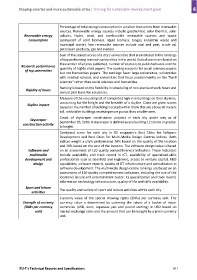Page 921 - Shaping smarter and more sustainable cities - Striving for sustainable development goals
P. 921
Percentage of total energy consumption in a nation that comes from renewable
sources. Renewable energy sources include geothermal, solar thermal, solar
Renewable energy voltaics, hydro, wind, and combustible renewable sources and waste
consumption (composed of solid biomass, liquid biomass, biogas, industrial waste and
municipal waste). Non‐renewable sources include coal and peat, crude oil,
petroleum products, gas and nuclear.
Sum of the scaled scores of a city's universities that are included in the rankings
of top performing research universities in the world. Scaled scores are based on
the number of articles published, number of citations to published work and the
Research performance
quantity of highly cited papers. The scoring accounts for social sciences papers
of top universities
but not humanities papers. The rankings favor large universities, universities
with medical schools, and universities that focus predominantly on the "hard
sciences" rather than social sciences and humanities.
Ranking is based on the flexibility in scheduling of non‐standard work hours and
Rigidity of hours
annual paid leave for a business.
Measure of the visual impact of completed high‐rise buildings on their skylines,
accounting for the height and the breadth of a skyline. Cities are given scores
Skyline impact
based on the number of buildings located within them that are above 90 meters
tall, with taller buildings receiving more points than smaller ones.
Count of skyscraper construction projects in each city under way as of
Skyscraper
construction activity September 26, 2010. A skyscraper is defined as any building 12 stories or greater
in height.
Combined score for each city in fDi magazine's Best Cities for Software
Development and Best Cities for Multi‐Media Design Centres indices. Both
indices weight a city's performance 70% based on the quality of the location
and 30% based on the cost of the location. The software design index is based
Software and on an assessment of 120 quality competitiveness indicators. These indicators
multimedia include availability and track record in ICT, availability of specialized‐skills
development and professionals such as scientists and engineers, access to venture capital, R&D
design capabilities, software exports, quality of ICT infrastructure and specialization in
software development. The multimedia design centre rankings are based on an
assessment of 120 quality competitiveness indicators, including the size of the
location's leisure and entertainment sector, its specialization and track record,
information technology infrastructure, quality of life and skills availability.
Sport and leisure
The quality and variety of sport and leisure activities within each city.
activities
Currency value of the special drawing rights (SDRs) per currency unit. The
Strength of currency currency value is determined by summing the values of a basket of major
(SDRs per currency currencies (USD, euro, Japanese yen and pound sterling) in USD based on
unit) market exchange rates and the amount that can be bought by a given currency
unit.
ITU‐T's Technical Reports and Specifications 911

